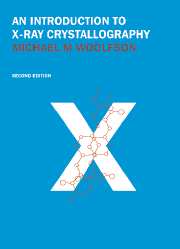Book contents
- Frontmatter
- Contents
- Preface to the First Edition
- Preface to the Second Edition
- 1 The geometry of the crystalline state
- 2 The scattering of X-rays
- 3 Diffraction from a crystal
- 4 The Fourier transform
- 5 Experimental collection of diffraction data
- 6 The factors affecting X-ray intensities
- 7 The determination of space groups
- 8 The determination of crystal structures
- 9 Accuracy and refinement processes
- Physical constants and tables
- Appendices
- Solutions to Problems
- References
- Bibliography
- Index
Preface to the First Edition
Published online by Cambridge University Press: 11 January 2010
- Frontmatter
- Contents
- Preface to the First Edition
- Preface to the Second Edition
- 1 The geometry of the crystalline state
- 2 The scattering of X-rays
- 3 Diffraction from a crystal
- 4 The Fourier transform
- 5 Experimental collection of diffraction data
- 6 The factors affecting X-ray intensities
- 7 The determination of space groups
- 8 The determination of crystal structures
- 9 Accuracy and refinement processes
- Physical constants and tables
- Appendices
- Solutions to Problems
- References
- Bibliography
- Index
Summary
In 1912 von Laue proposed that X-rays could be diffracted by crystals and shortly afterwards the experiment which confirmed this brilliant prediction was carried out. At that time the full consequences of this discovery could not have been fully appreciated. From the solution of simple crystal structures, described in terms of two or three parameters, there has been steady progress to the point where now several complex biological structures have been solved and the solution of the structures of some crystalline viruses is a distinct possibility.
X-ray crystallography is sometimes regarded as a science in its own right and, indeed, there are many professional crystallographers who devote all their efforts to the development and practice of the subject. On the other hand, to many other scientists it is only a tool and, as such, it is a meeting point of many disciplines – mathematics, physics, chemistry, biology, medicine, geology, metallurgy, fibre technology and several others. However, for the crystallographer, the conventional boundaries between scientific subjects often seem rather nebulous.
In writing this book the aim has been to provide an elementary text which will serve either the undergraduate student or the postgraduate student beginning seriously to study the subject for the first time. There has been no attempt to compete in depth with specialized textbooks, some of which are listed in the Bibliography. Indeed, it has also been found desirable to restrict the breadth of treatment, and closely associated topics which fall outside the scope of the title – for example diffraction from semi and non-crystalline materials, electron and neutron diffraction – have been excluded.
- Type
- Chapter
- Information
- An Introduction to X-ray Crystallography , pp. x - xiPublisher: Cambridge University PressPrint publication year: 1997

